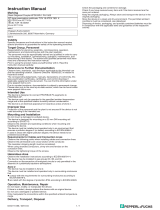Page is loading ...

Germany: +49 621 776 4411Pepperl+Fuchs Group
Refer to “General Notes Relating to Pepperl+Fuchs Product Information”.
USA: +1 330 486 0001 Singapore: +65 6779 9091
fa-info@de.pepperl-fuchs.com
1
Inclination sensor INY360D-F99-2I2E2-V17
Release date: 2013-04-22 13:58 Date of edition: 2013-04-22 201501_eng.xml
Model number
INY360D-F99-2I2E2-V17
Features
• Measuring range 0 ... 360°
• Analog output 4 mA ... 20 mA
• Evaluation limits can be taught-in
• 2 programmable switch outputs
• High shock resistance
• e1-Type approval
• Increased noise immunity 100 V/m
Electrical connection
Standard symbol/Connection:
+U
B
Out 2 (Y)
Out 1 (X)
Analogue output Y
Analogue output X
GND
-U
B
n.c.
I
1
7
5
3
8
2
4
6
EMC Properties
Emitted interference and interference immunity in accordance with motor vehicle directive 2006/28/EG (e1 Type approval)
Interference immunity in accordance with
DIN ISO 11452-2: 100 V/m
Frequency band 20 MHz up to 2 GHz
Mains-borne interference in accordance with ISO 7637-2:
Technical Data
General specifications
Type Inclination sensor, 2-axis
Measurement range 0 ... 360 °
Absolute accuracy ≤ ± 0.5 °
Response delay ≤ 25 ms
Resolution ≤ 0.1 °
Repeat accuracy ≤ ± 0.1 °
Temperature influence ≤ 0.027 °/K
Functional safety related parameters
MTTFd 300 a
Mission Time (TM) 20 a
Diagnostic Coverage (DC) 0 %
Indicators/operating means
Operating display LED, green
TEACH-IN indication 2 LEDs yellow (switching status), flashing
Button 2 push-buttons ( Switch points programming , Evaluation
range programming )
Switching state 2 yellow LEDs: Switching status (each output)
Electrical specifications
Operating voltage UB10 ... 30 V DC
No-load supply current I0≤ 25 mA
Time delay before availability tv≤ 200 ms
Switching output
Output type 2 switch outputs PNP, NO , reverse polarity protected ,
short-circuit protected
Operating current IL≤ 100 mA
Voltage drop ≤ 3 V
Analog output
Output type 2 current outputs 4 ... 20 mA
(one output for each axis)
Load resistor 0 ... 200 Ω at UB = 10 ... 18 V
0 ... 500 Ω at UB = 18 ... 30 V
Ambient conditions
Ambient temperature -40 ... 85 °C (-40 ... 185 °F)
Storage temperature -40 ... 85 °C (-40 ... 185 °F)
Mechanical specifications
Connection type 8-pin, M12 x 1 connector
Housing material PA
Protection degree IP68 / IP69K
Mass 240 g
Compliance with standards and
directives
Standard conformity
Shock and impact resistance 100 g according to DIN EN 60068-2-27
Standards EN 60947-5-2:2007
IEC 60947-5-2:2007
Approvals and certificates
CSA approval cCSAus Listed, General Purpose, Class 2 Power Source
e1 Type approval 2006/28/EG
Pulse 1 2a 2b 3a 3b 4
Severity level III III III III III III
Failure criterion C A C A A C
EN 61000-4-2: CD: 8 kV / AD: 15 kV
Severity level IV IV
EN 61000-4-3: 30 V/m (80...2500 MHz)
Severity level IV
EN 61000-4-4: 2 kV
Severity level III
EN 61000-4-6: 10 V (0.01...80 MHz)
Severity level III
EN 55011: Klasse A

Inclination sensor INY360D-F99-2I2E2-V17
2
Release date: 2013-04-22 13:58 Date of edition: 2013-04-22 201501_eng.xml
Germany: +49 621 776 4411Pepperl+Fuchs Group
Refer to “General Notes Relating to Pepperl+Fuchs Product Information”.
USA: +1 330 486 0001 Singapore: +65 6779 9091
fa-info@de.pepperl-fuchs.com
Sensor Orientation
In the default setting the zero position of the sensor is reached, when the electrical connection faces straight upwards.
- On request, all required mounting positions can be preset at the factory.
For example: X = 0 if the electrical connection points straight downwards.
X Orientation
Y Orientation
Dimensions
Button
104510
64
65
4 x ø 5.5
M12
730 718.5
37
LEDs
+
-
X = 0° X = 90° X = ±180° X = 270° (-90°)
Y = 0° Y = 90° Y = ±180° Y = 270° (-90°)
+
-
Pinout
Accessories
V17-G-2M-PUR
Female cordset, M12, 8-pin, shielded,
PUR cable
V17-G-5M-PUR
Female cordset, M12, 8-pin, shielded,
PUR cable
V17-G-10M-PUR
Female cordset, M12, 8-pin, shielded,
PUR cable
V17-G-10M-PVC-ABG
Female cordset, M12, 8-pin, shielded,
PVC cable
1
4
6
7
8
53
2
1 WH
2 BN
3 GN
4 YE
5 GY
6 PK
7 BU
8 RD
Wire colors
(white)
(brown)
(green)
(yellow)
(gray)
(pink)
(blue)
(red)

Inclination sensor INY360D-F99-2I2E2-V17
3
Release date: 2013-04-22 13:58 Date of edition: 2013-04-22 201501_eng.xml
Germany: +49 621 776 4411Pepperl+Fuchs Group
Refer to “General Notes Relating to Pepperl+Fuchs Product Information”.
USA: +1 330 486 0001 Singapore: +65 6779 9091
fa-info@de.pepperl-fuchs.com
Mounting of the sensor
Sensors from the -F99 series consist of a sensor module and accompanying cast aluminum housing. Select a vertical surface with minimum dimensions of 70 mm x
50 mm to mount the sensor.
Mount the sensor as follows:
1. Loosen the central screw under the sensor connection.
2. Slide back the clamping element until you are able to remove the sensor module from the housing.
3. Remove the sensor module from the housing
4. Position the housing at the required mounting location and secure using four countersunk screws. Make sure that the heads of the screws do not protrude.
5. Place the sensor module in the housing.
6. Slide the clamping element flush into the housing. Check that the sensor element is seated correctly.
7. Finally tighten the central screw.
The sensor is now mounted correctly.
LED display
Axis definition
The definition of the X-axis and Y-axis is shown on the sensor housing by means of imprinted and labeled double arrows.
Teach-in of switching points (X-axis)
1. Press key T1 > 2 s (see LED display)
2. Move sensor to switching position 1
3. Press key T1 briefly. LED "out 1" lights for 1.5 s as confirmation. Switching point 1 has been taught
4. Move sensor to switching position 2
5. Press key T1 briefly. LED "out 1" lights for 1.5 s as confirmation. Switching point 2 has been taught
6. Sensor returns to normal operation (see LED display)
If the switching points are taught in clockwise direction, the switching output between these switching points works as a NO contact. If the swit-
ching points are taught in anticlockwise direction, the switching output between these switching points works as a NC contact.
Teach-in of switching points (Y-axis)
1. Press key T2 > 2 s (see LED display)
2. Move sensor to switching position 1
3. Press key T2 briefly. LED "out 2" lights for 1.5 s as confirmation. Switching point 1 has been taught
4. Move sensor to switching position 2
5. Press key T2 briefly. LED "out 2" lights for 1.5 s as confirmation. Switching point 2 has been taught
6. Sensor returns to normal operation (see LED display)
If the switching points are taught in clockwise direction, the switching output between these switching points works as a NO contact. If the switching points are taught in anticlockwise direc-
tion, the switching output between these switching points works as a NC contact.
Teach-in of analog limits (X-axis)
1. Activate the teach-in mode for the analog limits by simultaneously pressing keys T1 and T2 > 2 s (see LED display)
2. Press key T1 > for 2 s (see LED display)
3. Move the sensor into the position of minimum evaluation limit
4. Press key T1 briefly. LED "out 1" lights for 1.5 s as confirmation. The minimum evaluation limit has been taught. In this position the analog output will provide its minimum output value.
5. Move the sensor into the position of maximum evaluation limit
6. Press key T1 briefly. LED "out 1" lights for 1.5 s as confirmation. The maximum evaluation limit has been taught. In this position the analog output will provide its maximum output value.
7. Sensor returns to normal operation (see LED display)
If the sensor inclination exceeds one of the analog limits, the last value of the analog output is retained.
Teach-in of analog limits (Y-axis)
1. Activate the teach-in mode for the analog limits by simultaneously pressing keys T1 and T2 > 2 s (see LED display)
2. Press key T2 > 2 s (see LED display)
3. Move the sensor into the position of minimum evaluation limit
4. Press key T2 briefly. LED "out 2" lights for 1.5 s as confirmation. The minimum evaluation limit has been taught. In this position the analog output will provide its minimum output value.
5. Move the sensor into the position of maximum evaluation limit
6. Press key T2 briefly. LED "out 2" lights for 1.5 s as confirmation. The maximum evaluation limit has been taught. In this position the analog output will provide its maximum output value.
7. Sensor returns to normal operation (see LED display)
If the sensor inclination exceeds one of the analog limits, the last value of the analog output is retained.
Resetting the sensor to factory settings
1. Press keys T1 and T2 > 10 s (see LED display)
2. The sensor has been reset when the green LED "Power" lights again after approx. 10 s.
Displays dependent on the operating state LED green:
Power
LED yellow
out 1
LED yellow
out 2
Teach-in of switching points (X-axis):
Teach-in of switching points (Y-axis):
off
off
flashes
off
off
flashes
Activate teach-in mode for analog limits:
Teach-in of analog limit (X-axis)
Teach-in of analog limit (Y-axis)
off
off
off
flashes
flashes
off
flashes
off
flashes
Normal operation on switchingstate switchingstate
Reset to factory settings:
2 s ... 10 s
> 10 s ... end of reset process
Followed by normal operation
off
flashes
flashes
off
flashes
off
Undervoltage flashes off off
5.
7.
6.
3 Nm
4.
1.
2.
3.
YX

Inclination sensor INY360D-F99-2I2E2-V17
4
Release date: 2013-04-22 13:58 Date of edition: 2013-04-22 201501_eng.xml
Germany: +49 621 776 4411Pepperl+Fuchs Group
Refer to “General Notes Relating to Pepperl+Fuchs Product Information”.
USA: +1 330 486 0001 Singapore: +65 6779 9091
fa-info@de.pepperl-fuchs.com
Undervoltage detection
If the supply voltage falls below a value of approx. 7 V, all outputs and yellow LEDs are deactivated. The green "Power" LED flashes rapidly. If the supply voltage exceeds a value of approx. 8 V, the
sensor continues with normal operation.
/

